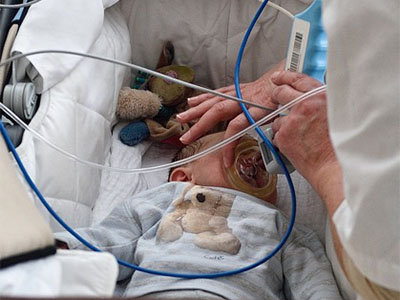Air pollutants and respiratory function of infants

Is the respiratory function of infants influenced by prenatal exposure to air pollutants?
A high number of studies suggest that prenatal exposure to air pollutants have detrimental effects on respiratory health and childhood asthma. Most research has assessed the respiratory function of the child after 5 years, and few studies have focused on fine particles smaller than 2.5 microns (PM2.5), which have the ability to go deep into the lung and enter the bloodstream. While fetal development and respiratory function show sex differences, few studies have explored differences in air pollution effects between girls and boys.
How was exposure to air pollution estimated?
Exposure to fine particles (PM2.5) and nitrogen dioxide (NO2) was estimated using individual sensors worn by pregnant women 2 or 3 times during pregnancy.
How was ventilatory function estimated?
The respiratory function of infants was assessed approximately six to seven weeks after birth. Various measurements were taken to calculate the volume of air inspired and expired with each breath (called tidal volume), respiratory rate (number of breaths per minute), and functional residual capacity (FRC), which represents the volume of air remaining in the lungs after an expiration.
Results
The average exposure was 20.2 μg/m3 for NO2 and 14.3 μg/m3 for PM2.5. The main result of the study suggests that prenatal exposure to PM2.5 may impair the respiratory performance of infants, with a decrease in functional residual capacity. This effect was more pronounced in girls, and a decrease in tidal volume was also observed. No effect of NO2 exposure on respiratory function was observed.
What makes this study innovative?
The novelty of this study lies in the evaluation of exposure to air pollutants using personal sensors, allowing for a precise estimation of exposures, taking into account indoor air and movements, while most studies focus on outdoor air exposure at participants' home address. The early measurement of respiratory function showed that the effects of air pollution could begin very early, while most studies that showed effects of air pollutants evaluated respiratory function from the age of 5.
What's next?
The research team continued investigations to determine if the associations observed at two months persisted as the children grew. See the article Air pollution during pregnancy and children’s respiratory health

To go further: Johanna Lepeule, Isabelle Pin, Anne Boudier, Joane Quentin, Sarah Lyon-Caen, Karine Supernant, Emie Seyve, Ryan Chartier, Remy Slama, Valerie Siroux, the SEPAGES study group; “Pre-natal exposure to NO2 and PM2.5 and newborn lung function: An approach based on repeated personal exposure measurements”; Environmental Research ; 2023 ; mars
Read the article